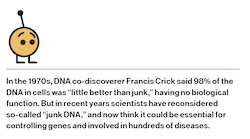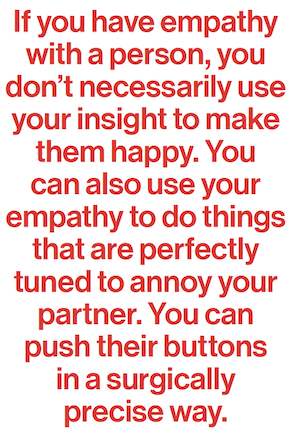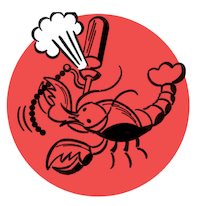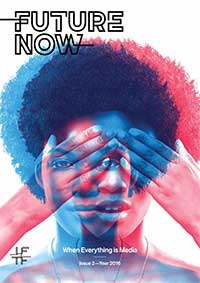Future Now
The IFTF Blog
Empathy Bugs
Empathy is infectious. But what happens when it’s an infection?
 “Look,” said Sally. She was pointing to something directly behind me. An annoying habit of hers. Always wanting me to share her experiences.
“Look,” said Sally. She was pointing to something directly behind me. An annoying habit of hers. Always wanting me to share her experiences.
“I don’t want to look,” I told Sally. “I don’t want to turn around.”
We’d just ordered our meal at Floppy Fish, an ultra-high-end restaurant on the wharf in Surf City. I was taking in the ambience—the hipster crowd, the offbeat eats, the ocean view, the handsome servers, and the play of emoticons around people’s faces.
Emoticons? Yep. I’m talking about augmented-reality images, overlaid onto my visual input by a synthetic encephalitis virus that I infected myself with. My employers were planning to brand the virus as EQ, for “emotional quotient,” in analogy to “IQ.” My dose was from an early batch—beta1.017y5, as I recall. It came from the research lab at Feel My Smeel, where I work as a biotech engineer. The day before, my boss Betty Yee had convinced me that, for the sake of the team, I should test EQ on myself, just like Albert Sandoz did with LSD after synthesizing it in 1943. Not that EQ is exactly a psychedelic. It’s a brain infection. But it’s not really bad for you.
I was glad to try EQ. I’ve never been great at reading people’s expressions—some would say I’m on the autism spectrum, although I don’t like hearing that. But now my brain’s EQ-infected cells would recognize the microemotions on the faces that I saw— and then they’d overlay my visual field with interpretive emoticons.
 Funny, clever emoticons, by the way. Yee-haw Texans, steam-whistle lobsters, sneering duchesses, pointed-mustache ponces, chortling toddlers, sneezy pepper shakers, dancers with fruit-basket hats, terrified tubas, low-bellied snakes, goofball slackers, triumphant matadors, sirens of the night, earnest hurdlers, and a dog licking his balls. Feel My Smeel had used deep-learning techniques to winkle out the 30 thousand most evocative images on the web, and they smoothed each image into a 3D emoticon ball.
Funny, clever emoticons, by the way. Yee-haw Texans, steam-whistle lobsters, sneering duchesses, pointed-mustache ponces, chortling toddlers, sneezy pepper shakers, dancers with fruit-basket hats, terrified tubas, low-bellied snakes, goofball slackers, triumphant matadors, sirens of the night, earnest hurdlers, and a dog licking his balls. Feel My Smeel had used deep-learning techniques to winkle out the 30 thousand most evocative images on the web, and they smoothed each image into a 3D emoticon ball.
As an aside, a risk with witty emoticons is that if, say, you have trouble telling when people are joking—well, then maybe you won’t be able to tell when an icon represents a joker. To remedy this, the viral EQ biocomputation displayed several emoticons at a time, from the crude to the subtle, wreathing images around any face that you focused on.
 But, wait a minute, what does a virus-based hive-mind know about witty emoticons? Well, the Feel My Smeel labs had spliced a huge amount of so-called “junk DNA” into the EQ virus’ stinger- like tails. The splicing had been, in fact, my job. And that extra DNA isn’t really junk, no indeed; it’s richly encrypted biocomputational code.
But, wait a minute, what does a virus-based hive-mind know about witty emoticons? Well, the Feel My Smeel labs had spliced a huge amount of so-called “junk DNA” into the EQ virus’ stinger- like tails. The splicing had been, in fact, my job. And that extra DNA isn’t really junk, no indeed; it’s richly encrypted biocomputational code.
As an additional boost, people’s EQ infections could work in tandem. Like cloud computing. To make this happen, the EQ viruses use the otoliths of their hosts’ inner ears as wireless antennae. When my EQ wireless really gets going, I hear the rattle of the tiny rocks in my head. A scritchy buzz.
Oh, and one more win here: the wireless connection allowed Feel My Smeel to push out DNA upgrades to existing EQ viruses in the field.
When I infected myself with EQ, I felt feverish for a while. I lay down for a nap on my office couch and had unpleasantly lifelike dreams, urgent and writhing. I woke with a strangled cry.
Betty Yee was like, “Are you okay?” Emoticons were swarming around her like flies around a cartoon beatnik. I told her I was fine, and I rode my wobbly bicycle away from Feel My Smeel as fast as I could. My wife Sally was already home. Jackpot. Right away I was grokking her better than ever before. Responding to her unspoken cues, and saying the right things. I made supper, and we had sex for the first time in weeks. Score one for EQ.
Sally dropped off to sleep, but around midnight she started twitching and moaning. She woke from troubled dreams and sat bolt upright, eyes wild. She’d caught the EQ infection from me. They’d colonized the cells of her brain. Naturally I couldn’t hide the facts from her. She was totally pissed off. Radiating a blizzard of emoticons. Microexpressions of rage, bewilderment, and fear. Not to mention a bunch of verbalizations and macroexpressions that even a guy on the spectrum could read.
The next day I went to the lab at Feel My Smeel, and I had it out with Betty Yee. She’d assured me in advance that the EQ virus wasn’t contagious. She’d been lying. One of the emoticons beside her face couldn’t stop blushing and giggling.
“All right then, Scott,” Betty said after a while. “This is bigger than you realized, yes. Ken Yao wants everyone to get EQ.” At this point I saw an emoticon of an insane, ranting dictator—reflecting Betty’s actual feelings about Ken Yao. Ken being the seldom-seen top guy at Feel My Smeel.
“But—launching a pandemic?” I said.
“If everyone catches EQ, there’s nobody left to point a finger,” said Betty. “EQ is for the public good, Scott. It’s altruistic. The EQ virus—we know it’s making you feel better.” A sly spy emoticon appeared: a woman in shades, a beret, and a black cape.
“And you know I feel better—because?” said I.
“EQ wireless feedback,” said Betty with a shrug. “The human race is meant to be a network.”
“I should blow the whistle on you and Ken Yao,” I said.
“Play along,” said Betty. Money-bag icons danced around her head. “We need you on the team, Scott. Ken has authorized me to cut you in for a block of founders’ stock. It’ll be worth a ton when we go public this week. Just sign here and here and here.”
 So I signed, and I took the rest of the day off. Sally had stayed home from her teaching job, moping about her EQ infection. She cheered up, to some extent, when I told her we’d be multi-millionaires. We dressed up and went to the Floppy Fish restaurant, looking to have a big, what-the-hell celebration. I said we should get used to our EQ infections—and accept that they might last for the rest of our lives. EQ wasn’t necessarily a bad thing. The two of us were getting along much better than usual.
So I signed, and I took the rest of the day off. Sally had stayed home from her teaching job, moping about her EQ infection. She cheered up, to some extent, when I told her we’d be multi-millionaires. We dressed up and went to the Floppy Fish restaurant, looking to have a big, what-the-hell celebration. I said we should get used to our EQ infections—and accept that they might last for the rest of our lives. EQ wasn’t necessarily a bad thing. The two of us were getting along much better than usual.
Not that it was completely smooth sailing. If you have empathy with a person, you don’t necessarily use your insight to make them happy. You can also use your empathy to do things that are perfectly tuned to annoy your partner. You can push their buttons in a surgically precise way.
For instance, after we sat down at the Floppy Fish, and Sally asked me turn around to look at whatever bullshit she thought she’d seen, and I rudely said I didn’t want to—well, then she pushed my buttons to make me feel like a rat.
“You hate me.” Floating beside Sally’s head was the emoticon of a bereft little girl in rags, lying on reathe ground, her thin shoulders shaking with sobs.
Zap! Empathy arrowed into me. A spasm of remorse. I groaned theatrically, and twisted my body so I could look behind me. “What?” I asked Sally. “What am I supposed to see?”
“A—bug?” said Sally. An emoticon of an intrigued woman with big glasses. “I can’t really see the bug’s body—just the flutter of, like, gossamer wings. Glints of light. I suppose it’s an emoticon, but it seems—different. Do you see it, Scott?”
“No.” This was the secondary problem. First Sally would ask me to drop what I was doing to look at something—and then I wouldn’t be able to see it. I’m not all that observant. Especially when I’m feeling coerced. “Sorry,” I said with a shrug. “But I frikkin see nothing. Now let me check out this scene on my own. Thanks to EQ, we have empathy, and that’s fine, but I’m still not an extension of your personality, okay?”
“Callous tyrant,” said Sally. Emoticon of a Soviet-poster-style striker, fist raised. “Keep looking. The flying bug was right beside that man wearing a T-shirt and a backwards baseball hat. That’s a very expensive designer hat and T-shirt, you understand. I figure this guy and his friends for hedge fund traders. He’s the one eating abalone on polenta with morels and squid-ink sauce? And now suddenly he’s jabbering about—wanting stock in Feel My Smeel! Your company, Scott. Do you see the top-hatted capitalist emoticon by his face?”
Mainly I was noticing the latest emoticon by Sally’s head. A keen-eyed British detective woman in a tweed suit.
“How does the glinting bug fit into your case?” I asked.
“I think it’s on the other side of the designer-baseball-hat guy’s head,” said Sally. “I think it’s feeding him market tips.”
“Quit it,” I said. I didn’t like where our conversation was going. What if Ken Yao and Feel My Smeel were far more devious than I’d realized? But right now I wanted to eat and be happy. I faked a smile. No dice.
“You’re crabby, Scott,” said Sally. “And dull. And uptight. Oh, the emoticons around your face! Like—I see a sour, lawn-dwarf gnome wringing his hands. The inner you.”
“I—I can see the gnome too,” I said, a little surprised. I turned my head back and forth. “I can see—I can see all the same emoticons that you see, Sally. And that must be because, uh, there’s feedback between our EQ virus infections. Cross-chatter. All the EQ people are networked. That’s a feature we designed in. So, hmm, maybe the baseball-hat hedge-fund man has EQ, and the glinting bug is his vision.”
“Blah blah blah,” went Sally. A surfer-girl emoticon stuck out its tongue at me. Kind of cute. But also annoying. I wanted Sally to acknowledge how smart I was.
“Look,” I said, pointing past her shoulder. “Look, look.”
Her face clouded over. Thanks to EQ, she knew I was mocking her. “Oh, let’s eat whatever we ordered and get it over with,” she said. “This isn’t much of a celebration. I suppose you want to get back to your work. Tweaking—I think you said it’s the EQ virus’ face-wrinkle-recognition algorithm? As if you ever recognize anything. You’re blind as a bat.” Unexpectedly her voice broke. “I wish for once we could have fun, Scott. We’re like two convicts chained together.”
 Sally’s emoticon: a weary, raw-boned woman in a death-row cell. Hopeless despair.
Sally’s emoticon: a weary, raw-boned woman in a death-row cell. Hopeless despair.
“I’m sorry,” I said with a heavy sigh. “One reason I’ve been working so hard on EQ is that I want to get better. I want you to be happy with me. I’ll look at that glinting bug if you see it again, sure.” I grappled for a fresh topic. “The ocean is pretty isn’t it?”
“Looks cold. Grim.”
“Gnarly,” I said. “Chaotic.”
“Here comes the chaos routine,” said Sally. Emoticon of a student asleep at a desk.
I pressed on. “Everything good is chaotic. Chaos says we could look out this window for a trillion years, and we’d never see exactly the same surf again. Nothing has to be stale. You and I—this conversation will never exactly repeat.”
“Not so sure about that,” said Sally, starting to smile. And then her eyes brightened. “Look now, Scott! Quick. The bug thingy is back. It’s buzzing the other men at the table.”
I whirled. And, yes, I saw the bug. Twinkling before the faces of the baseball-hat man and his trader pals. It was holding a little stock chart and tapping on it with a tiny pointer. All four of the men were watching. And that meant all four of them were EQ infected. This pandemic was fast.
And what was the glinting bug? It was a Feel My Smeel ad. An ad in augmented reality.
And where was the bug from? It was being biocomputed by the EQ-infected cells in my brain. Without realizing it, I’d been wirelessly overlaying the image onto the visual fields of my EQ-enhanced neighbors. I was, in effect, a down-andouter waving a SALE sign on a street corner.
 At this point our server appeared, and Sally and I got into a tureen of cioppino and a bottle of sparkling wine. The room was really livening up. People were laughing their asses off, having tearful reconciliations, and starting loud fights. Wild emotional swings.
At this point our server appeared, and Sally and I got into a tureen of cioppino and a bottle of sparkling wine. The room was really livening up. People were laughing their asses off, having tearful reconciliations, and starting loud fights. Wild emotional swings.
“Eat, drink, and be merry,” said Sally. “For tomorrow we die.”
“Nobody’s going to die,” I assured her. Already I was getting ideas. My EQ viruses were helping me. They didn’t like being used for ads. EQ was too good for that. For the first time in awhile I felt totally happy. “Everything will be fine,” I said.
“Every single person in here has EQ,” said Sally. Her emoticon: a sly girl stoner, leaning against a wall, flicking her eyes back and forth. “That’s why they’re so hyper.”
“I’m with you,” I said. “I’m keying your waves. The pandemic has landed. And are you picking up on the—”
“Ads,” said Sally, glancing around. “More of them all the time. From bottom feeders. Crokee Cola, Timor cars, and vacations in North Korea.”
“Early adopters,” I said. “Now that Feel My Smeel has a globally networked augmented-reality communication channel in place—yeah. They’re monetizing it.”
“And never mind the empathy,” said Sally. She waved a crab claw in the air, as if to drive off the acrobatic troupe of AR Crokee Cola cans that hovered over our table. “I don’t think people can stand this, Scott.”
“It’ll be different tomorrow,” I reassured her. “I’ll work all night if I have to. I’ll find a fix.”
“Use chaos to wake up the emoticons?” suggested Sally.
“Perfect.”
Once we got home I logged into my Feel My Smeel account and put chaotic jiggles into the EQ viruses’ biocomputational routines. The company still trusted me, and I had full access. For my chaos source, I set up a little model of Earth’s atmosphere, with her endlessly seething, eternally unpredictable scrolls. With the toy Gaia running, it was like we had a live drummer in the mix—instead of a drum machine.
Instead of always being the same, our emoticons would be mutating and—evolving. My expectation was that our funky emoticons would become—for want of a better word—alive. Augmented reality artificial- life critters. They’d totally destroy anything so stodgy and weak as an ad.
How fast could I make the change happen? Well, the underlying computation was running on our EQ viruses, right? And, brute numerical fact, there were a quadrillion of these bugs in people’s bodies by now. With that kind of crunch power, a computational transition can happen hella fast.
Sally and I sat down in our shared home office and, while I worked, she generated a wreath of mad-scientist emoticons around my head. Fine with me. I was laughing and feeling high—talking to Sally, and to her emoticons, and to my emoticons, and to my little model of Earth, all at the same time.
And then I pulled the trigger. That is, I used the Feel My Smeel biotech servers to push out my biocomputational upgrade to our deployed EQ viruses, thereby bringing wholesome chaos to each and every strand of our proprietary DNA. The otoliths in my inner ear hummed.
“Nothing seems different yet,” said Sally.
“It’ll take a few hours to sink in. We’ll be emulating, like, a million years of evolution overnight.”
“So let’s go to bed,” she said. “A big sleep. And, oh, look at you. Hopeful romance emoticons.” Her emoticons were very promising too.
When Sally and I awoke, we looking at a new world of EQ-augmented reality.
 Busy little images drifted around our bedroom like butterflies, or tropical fish, or miniature alien invaders, or—living dreams.
Busy little images drifted around our bedroom like butterflies, or tropical fish, or miniature alien invaders, or—living dreams.
“Greetings,” said a cheerful little bird with a pencil stub for his head. He was standing on the sheet beside my pillow. “Would you like me to write a math proof?”
“Won’t be real math, though,” said a wee, spotted dragon who hovered above our bed. “It’ll be augverse math.”
“Augverse?” said Sally.
“The EQ layer of reality,” said I. “Which is being computed on the fly. Like a living cartoon. This is going to be fun.”
“What about the ads?” Sally asked the dragon. “Will there still be ads?”
“We swallow the ads,” said the little pencil-bird. “They’re dumb. Not fit to be seen. And we’ll block any further code upgrades from Feel My Smeel.”
“Wow.”
“Can I ask a favor?” said the spotted dragon. “Will you two have French toast for breakfast? For the quebecol in maple syrup.”
“And sprinkle on some fennel seeds,” added the pencil-bird. “For the fenchone.”
“Quebecol and fenchone are for the EQ viruses?” said Sally.
“Good for them, good for us, good for you,” said the dragon. “We’re allies now. A new day.”
“Hooray for Scott,” said Sally. The newly intelligent emoticon critters weren’t bothering to do interpretation anymore, but I studied Sally’s face on my own—and I could see she was being nice.
“I love you,” I said.
“Now we’re talking.”
We went and had breakfast.
 FUTURE NOW—When Everything is Media
FUTURE NOW—When Everything is Media
In this second volume of Future Now, IFTF's print magazine powered by our Future 50 partnership, we explore the future of communications, tracing historical technology shifts through the present and focusing on the question: “What is beyond social media?”
Think of Future Now as a book of provocations; it reflects the curiosity and diversity of futures thinking across IFTF and our network of collaborators. This issue contains expert interviews, profiles and analyses of what today’s technologies tell us about the next decade, as well as comics and science fiction stories that help us imagine what 2026 (and beyond) might look and feel like.
About IFTF's Future 50
Every successful strategy begins with an insight about the future. Every organization needs to build the capacity to anticipate the future. The Future 50 is a side-by-side relationship with Institute for the Future; it’s a partnership focused on strategic foresight on a ten-year time horizon. With 50 years of futures research in society, technology, health, the economy, and the environment, IFTF has the perspectives, networks, signals, and tools to make sense out of the emerging future.
For More Information
For more information on IFTF's Future 50 Partnership and Tech Futures Lab, contact:
Sean Ness | [email protected] | 650.233.9517



